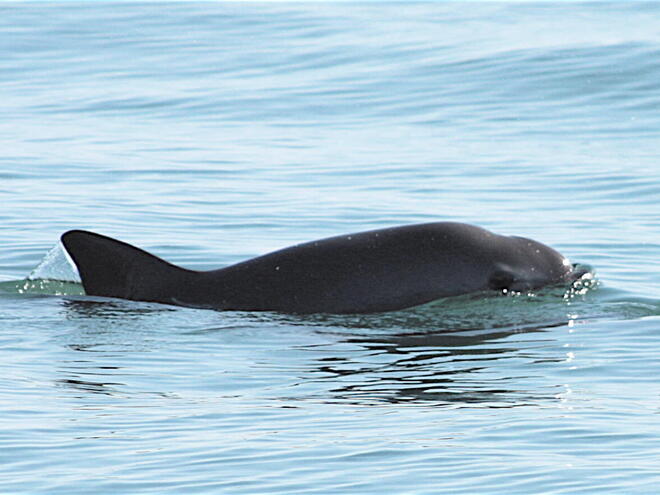Swimming Near the Edge: The Decline of the Vaquita
Written by: Aleksandar Simeunovic
Deep beneath the waves of the pacific ocean, two tiny porpoises speed past each other, communicating through a series of high-pitched whistles and clicks. They play with each other, spinning and doing tricks as if they are dancing. These adorable animals are called Vaquitas (Phocoena sinus) and can only be found in a small portion of the eastern Pacific Ocean. This is the story behind this beautiful species and its tragic demise as it moves closer and closer to the brink of extinction.
A Biodiverse Treasure Trove
In the far western edge of Mexico lies the Sea of Cortez, a large inlet dotted with hundreds of islands. The sea’s greatest surprise lies beneath its picturesque blue waves, which hide a plethora of biodiversity. This area is home to many of the world’s most famous aquatic species, leading to it being dubbed as “The Aquarium of the World ” by world-renowned explorer Jacques Cousteau. Due to the sea’s temperature in that area, it is only able to support a large reef system in one spot close to its southern edge, which means that a large portion of the biodiversity comes from large vertebrates. Populations of plankton and squid form the bottom links of the massive food chain needed to support these creatures. Combined, these two factors make the Sea of Cortez one of the best places in the world for large aquatic animals to thrive.
What the Sea of Cortez is really known for is its cetaceans. This is an order of mammals that includes dolphins, whales, and porpoises. 33 out of 86 species of cetaceans currently recognized in the world can be found in this region of the world! The family also includes some of the largest creatures to call our planet home, such as the killer (Orcinus orca), humpback (Megaptera novaeangliae), and fin whales (Balaenoptera physalus), as well as their record-holding cousin; the blue whale (Balaenoptera musculus). While many cetaceans can reach truly impressive sizes, it is the smallest one that this story revolves around— the Vaquita.
Figure 1

The Gulf of California, also known as the Sea of Cortez, is one of the most biodiverse locations in the entire world.
Source: undark.org
A Shy Friend
Being the smallest living cetacean, the Vaquita weighs in at an average of 55 kilograms and grows from 1.4 meters long (males) to 1.5 meters long (females). Rather than eating tons of food like their cousins, their diet centers around small fish and squid. Vaquita hunt individually as they are known to be solitary animals. However, if they are found in groups, they never number more than two to three, communicating through sonar in the same way as other cetaceans.
The Vaquita has a very specialized habitat, swimming no more than 25 kilometers from shore and staying in shallow lagoons up to 28 meters deep. Being the only type of porpoise living in such warm waters, the Vaquita has evolved to have very large dorsal fins. Scientists believe this is to allow the Vaquita’s body heat to dissipate more efficiently. The higher abundance of predators has also helped them to evolve a unique color scheme that is dark grey on top, pale grey on the sides, and white on the bottom. Black markings around the lips make it look as if the Vaquita is always smiling. The famous black rings around the eyelids have led to the coining of their nickname; “Panda of the Sea.”
Figure 2

A vaquita breaching the surface of the waves for some air. Since they are mammals, Vaquita need to breach about once every three minutes.
Source: WWF.org
The Beginning of the End
The tale of the decline of the Vaquita is quite long and begins across the world’s largest ocean on an entirely separate continent. For centuries, wealthy Chinese citizens have craved Fish Maw, a delicacy made from the swim bladder of a specific fish. Totoaba (Totoaba macdonaldi), from whom the bladders come, use them to regulate buoyancy while swimming. The bladder has become incredibly valuable, fetching up to $46,000 for every kilogram sold. This has led many to pursue illegal poaching in order to reap profits, significantly harming the Totoba population.
Totoaba are very large fish, and Vaquita are very small cetaceans, ending up being a similar size to each other. Gillnet fishing, the primary method used by totoaba poachers, involves spreading long nets underwater in order to catch the fish while they are swimming. The mesh sizing of the net is meant for catching Totoaba, but helpless Vaquita also end up getting caught within the nets. Since they are mammals and require breaching the surface of the water for air, they drown within minutes of becoming entangled within the net. Sadly, this has been the primary cause of their population decline from 600 individuals in 1997 to a mere ten individuals in 2021.
Figure 3

A vaquita lying amidst a fishing net. Due to entanglement with fishing wires, vaquita populations dropped by over 90% between 2011 and 2016.
Source: nytimes.org
Hope on the Horizon
The plight of the Vaquita has not gone unnoticed by everyday civilians and governments alike. In an effort to re-establish Vaquita populations, the Mexican government put a 2-year complete ban on gillnet fishing in 2015, which was turned into a permanent ban in 2017. But, despite being compensated for income loss, fishermen continued to illegally use gillnets in the sea, contributing to even more decreases in the population. Both the Mexican government and scientific institutions have conducted surveys about the Vaquita population, using a combination of ship-based monitoring and sound-based detectors to capture the species distinct clicks and whistles.
Alongside the government’s efforts, everyday citizens have also taken part in conservation efforts. People have written letters, signed petitions, sent donations, and boycotted certain seafood types, all in an effort to save our beloved tiny cetacean. In fact, a day in July every single year is dedicated to saving the Vaquita. On this day, people from around the world do what they can to help save the “Panda of the Sea.”
What is one of the more creative approaches to this problem was conceived by none other than the United States Navy. The United States Navy Marine Mammal Program includes 75 dolphins and about 30 sea lions. These are trained for a multitude of tasks, such as minesweeping and finding missing scuba divers. Recently, the program has teamed up with the Mexican government to use its bottlenose dolphins as guides for the Vaquita, in order to find them and bring them to protected areas where they can be monitored as much as possible. While efforts like these show that there is still some hope, we were much too late.
Figure 4

A Vaquita day celebration in Hong Kong. Celebrations take place around the world as people do their part in support of the smallest cetacean.
Source: vivavaquita.org
A Lesson to be Learned
Citizens and governments have banded together in an effort to save the Vaquita, which is amazing, but the truth is that it may already be too late. With the population dropping to single digits, it may become impossible to bring the Vaquita back, but that does not mean we can’t learn from our mistakes. We can organize ourselves to save our planet with the utmost urgency. By following the warning signs years in advance, we can prevent the fall of the Vaquita from repeating itself through other species in the future.
References and Sources
2021: The Year that could save or kill the vaquita: Earth.org – past: Present: Future. Earth.Org – Past | Present | Future. (n.d.). Retrieved November 9, 2021, from https://earth.org/data_visualization/2021-the-year-that-could-save-or-kill-the-vaquita/.
BBC. (2017, July 1). Vaquita Porpoise: Dolphins deployed to save rare species. BBC News. Retrieved November 9, 2021, from https://www.bbc.com/news/science-environment-40466607.
Bessesen, B., & Safina, C. (2018). Vaquita: Science, politics, and crime in the Sea of Cortez. Island Press.
Center for Biological Diversity. (n.d.). Saving the Vaquita. Vaquita. Retrieved November 9, 2021, from https://www.biologicaldiversity.org/species/mammals/vaquita/.
Felbab-Brown, V. (2017, June 6). The vanishing vaquita and the challenges of Combating Wildlife Trafficking. Brookings. Retrieved November 9, 2021, from https://www.brookings.edu/blog/order-from-chaos/2017/06/05/the-vanishing-vaquita-and-the-challenges-of-combating-wildlife-trafficking/.
Fisheries, N. O. A. A. (n.d.). Vaquita. NOAA. Retrieved November 9, 2021, from https://www.fisheries.noaa.gov/species/vaquita.
The impending extinction of the vaquita is not just a fishing problem – it’s a social and ecological one too. Nereus Program – The Nippon Foundation. (n.d.). Retrieved November 9, 2021, from https://nereusprogram.org/works/the-impending-extinction-of-the-vaquita-is-not-just-a-fishing-problem-its-a-social-and-ecological-one-too/.
International save the vaquita day – viva vaquita: Working to save the Vaquita Porpoise. VIVA Vaquita | Working to Save the Vaquita Porpoise. (2021, July 26). Retrieved November 10, 2021, from https://vivavaquita.org/international-save-the-vaquita-day/.
Jaramillo-Legorreta, A. M., Cardenas-Hinojosa, G., Nieto-Garcia, E., Rojas-Bracho, L., Thomas, L., Ver Hoef, J. M., Moore, J., Taylor, B., Barlow, J., & Tregenza, N. (2019). Decline towards extinction of Mexico’s vaquita porpoise ( Phocoena sinus ). Royal Society Open Science, 6(7), 190598. https://doi.org/10.1098/rsos.190598
Jesse Rodenbiker (2020, August 6). The last hope for the Vaquita Porpoise lies with the consumer. chinadialogue ocean. Retrieved November 9, 2021, from https://chinadialogueocean.net/14478-vaquita-last-hope-lies-with-consumer/.
March 05, 2020 N. R. D. C. (2020, March 5). Near-extinct vaquita porpoise gets thrown another lifeline. NRDC. Retrieved November 9, 2021, from https://www.nrdc.org/experts/nrdc/near-extinct-vaquita-porpoise-gets-thrown-another-lifeline.
Mark Stevenson, T. A. P. (2017, August 8). U.S.-trained dolphins to help locate Mexico’s vaquita porpoise. Navy Times. Retrieved November 9, 2021, from https://www.navytimes.com/news/your-navy/2017/01/04/u-s-trained-dolphins-to-help-locate-mexico-s-vaquita-porpoise/.
Medrano 05.20.2019, L., Bender 06.14.2021, E., & Tran 01.22.2021, L. (2020, January 27). Fates intertwined: Vaquitas, totoabas, and fishing on the Sea of Cortez. Undark Magazine. Retrieved November 10, 2021, from https://undark.org/2019/05/20/fates-intertwined-vaquitas-totoabas-and-fishing-on-the-sea-of-cortez/.
Parker, R. (2019, March 19). Will Mexico save its vanishing vaquita? The New York Times. Retrieved November 9, 2021, from https://www.nytimes.com/2019/03/19/opinion/mexico-porpoise-extinction.html.
Roth, A. (2021, May 3). The vaquita nears extinction. Animals. Retrieved November 9, 2021, from https://www.nationalgeographic.com/animals/article/vaquita-the-porpoise-familys-smallest-member-nears-extinction.
Save the endangered vaquita. Porpoise Conservation Society. (2018, July 5). Retrieved November 9, 2021, from https://porpoise.org/save-the-vaquita/.
Society for Conservation Biology | Save the vaquita. (n.d.). Retrieved November 9, 2021, from https://conbio.org/groups/sections/marine/save-the-vaquita.
Vaquita. IUCN SSC Cetacean Specialist Group. (n.d.). Retrieved November 9, 2021, from https://iucn-csg.org/vaquita/.
The vaquitas plight: A race against extinction. The Vaquitas Plight: A Race Against Extinction. (n.d.). Retrieved November 9, 2021, from http://digital.ecomagazine.com/publication/?i=378199&article_id=2692482&view=articleBrowser&ver=html5.
World Wildlife Fund. (2015, March 11). A lifeline for Vaquita. WWF. Retrieved November 9, 2021, from https://www.worldwildlife.org/stories/a-lifeline-for-vaquita.